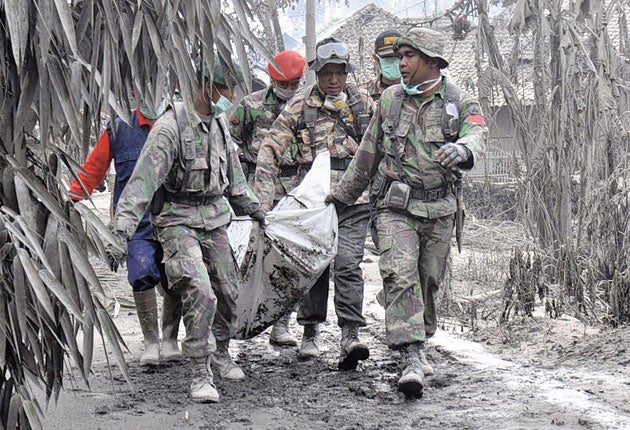Gas avalanche incinerates villagers after volcano blast

Searing heavy gas avalanched down an Indonesian volcano with a thunderous roar, torching houses and trees and incinerating villagers as they fled Mount Merapi's worst eruption in a century. Scores of bodies found yesterday raised the known death toll to 122.
The injured – with clothes, blankets and even mattresses fused to their skin by the 1,400F (750C) heat – were carried away on stretchers after the first big explosion just before midnight.
All day yesterday, Merapi shot towering plumes of ash that clogged the windshields of cars 300 miles (480km) away. Bursts of hot clouds occasionally interrupted aid efforts, with rescuers screaming: "Watch out! Hot cloud!"
Before yesterday, the toll stood at 44, most dying in the first blast on 26 October. The intensifying eruptions have baffled scientists who have monitored the mountain for years, and left them uncertain what to expect. Dozens of explosions that followed Merapi's initial blast had been predicted to ease pressure behind a magma dome. The danger zone residents have been ordered to flee has now been expanded to 12 miles (20km) from the crater.
Friday's explosion – said by vulcanologists to be the biggest since the 1870s – hit hardest in Bronggang, a village nine miles (15km) from the crater. Soldiers joined the rescue operations, pulling at least 78 bodies from homes and streets blanketed by ash up to one foot (30cm) deep. Crumpled roofs, charred carcasses of cattle and broken chairs – all layered in white soot – dotted the smouldering landscape.
The volcano, in the heart of the densely populated Java island, has erupted scores of times, killing more than 1,500 people in the past century alone. But tens of thousands of people live on its rolling slopes, drawn to soil made fertile by lava and volcanic debris.
"The heat surrounded us and there was white smoke everywhere," said Niti Raharjo, 47, who was thrown from his motorbike along with his 19-year-old son while trying to flee. "I saw people running, screaming in the dark, women so scared they fell unconscious," he said in hospital where they were both being treated for burns. There was an explosion that sounded like it was from a war ... and it got worse, the ash and debris raining down."
With bodies found in front of houses and in streets, it appeared that many of the villagers died from the searing gas while trying to escape, said Colonel Tjiptono, a deputy police chief.
More than 150 injured people – with burns, respiratory problems, broken bones and cuts – waited to be treated at the tiny Sardjito hospital, where the bodies piled up in the morgue, and two other hospitals. "We're totally overwhelmed here," a spokesman said.
In terms of the amount of volcanic material released, 1,765 million cubic feet (50 million cubic meters), "it was the biggest in at least a century", Gede Swantika, a state vulcanologist, said as plumes of smoke continued to shoot up more than 30,000ft (10,000m).
More than 100,000 people on Merapi have been evacuated to crowded emergency shelters, many by force, in the past week. But some return to their villages in an attempt to tend to their surviving livestock. The government has announced an $11m programme to buy the cows on the mountain to keep farmers off its slopes, and to compensate for dead animals.
Even scientists from Merapi's monitoring station were told they had to pack up and move down. They were scrambling to repair four of their five seismographs destroyed by the heavy soot showers.
Join our commenting forum
Join thought-provoking conversations, follow other Independent readers and see their replies
Comments
Bookmark popover
Removed from bookmarks